List_of_heads_of_state_of_Iran
This article lists the heads of state of Iran since the establishment of the modern Iranian nation-state[1] in 1501 AD.
More information The Expansive Realm of Iran (1501–1736) Safavid dynasty, No. ...
The Expansive Realm of Iran (1501–1736)Safavid dynasty | |||||||
|---|---|---|---|---|---|---|---|
| No. | Name | Birth–Death | Reign start | Reign end | Dynasty | ||
| Shah of Persia | |||||||
| 1 | Shah Ismail I |  |
1487–1524 | July 1501[lower-alpha 1] | 23 May 1524 | Safavid | |
| . | |||||||
| 2 | Shah Tahmasp I | 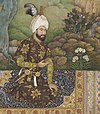 |
1514–1576 | 23 May 1524 | 14 May 1576 | Safavid | |
Regency:
| |||||||
| 3 | Shah Ismail II |  |
1537–1577 | 23 May 1576 | 24 November 1577 | Safavid | |
| . | |||||||
| 4 | Shah Mohammad Khodabanda |  |
1532–1595/96 | 11 February 1578 | 1 October 1588 | Safavid | |
| . | |||||||
| 5 | Shah Abbas I | 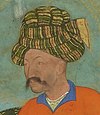 |
1571–1629 | 1 October 1588 | 19 January 1629 | Safavid | |
| . | |||||||
| 6 | Shah Safi | 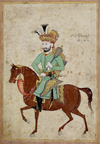 |
1611–1642 | 28 January 1629 | 12 May 1642 | Safavid | |
| . | |||||||
| 7 | Shah Abbas II | 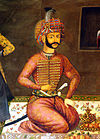 |
1632–1666 | 12 May 1642 | 25 September 1666 | Safavid | |
| . | |||||||
| 8 | Shah Suleiman I |  |
1648–1694 | 1 November 1666 | 29 July 1694 | Safavid | |
| . | |||||||
| 9 | Shah Sultan Husayn |  |
1668–1726 | 6 August 1694 | 23 October 1722 |
Safavid | |
| . | |||||||
Ghilji rebellion | |||||||
| 10 | Mahmud Shah | 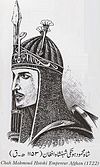 |
1699–1725 | 23 October 1722 | 25 April 1725 | Hotak | |
| . | |||||||
| 11 | Ashraf Shah | 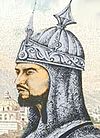 |
1700–1730 | 26 April 1725 | 13 November 1729 | Hotak | |
| . | |||||||
Safavid restoration | |||||||
| 12 | Shah Tahmasp II |  |
1704–1740 | 10 November 1722 | 2 September 1732 | Safavid | |
He was crowned on 9 December 1729 after liberation of the Safavid Capital. Reigned at exile:
| |||||||
| 13 | Shah Abbas III |  |
1732–1740 | 2 September 1732 | 8 March 1736 | Safavid | |
Realm of Iran (1736–1796)Afsharid dynasty | |||||||
| 14 | Nader Shah | 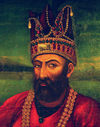 |
1688–1747 | 8 March 1736 | 20 June 1747 | Afsharid | |
| . | |||||||
| 15 | Adil Shah |  |
1719–1749 | 6 July 1747 | 29 September 1748 | Afsharid | |
| . | |||||||
| 16 | Ebrahim Shah |  |
1724–1749 | 29 September 1748 | May 1749 | Afsharid | |
| . | |||||||
| 17 | Shahrokh Shah |  |
1734–1796 | May 1749 | 30 December 1749 | Afsharid | |
| Proclaimed as Shah at 30 September 1748 and one day later crowned at Mashhad. | |||||||
Second Safavid restoration | |||||||
| 18 | Suleiman II |  |
1714–1763 | 13 January 1750 | 20 March 1750 | Safavid | |
| Proclaimed after deposing and blinding of Shahrokh Shah and crowned at 14 January 1750. | |||||||
| 19 | Ismail III |  |
1733–1773 | 29 June 1750 | 1773 | Safavid | |
He was a Puppet ruler who raised to the throne by Ali Mardan Khan Bakhtiari and Karim Khan Zand as a front to legitimize their rule.[7] Regency:
| |||||||
Afsharid restoration | |||||||
| (17) | Shahrokh Shah |  |
1734–1796 | 9 May 1755 | 14 May 1796 | Afsharid | |
| . | |||||||
Zand dynasty | |||||||
| Wakil-al Raʿāyā | |||||||
| 20 | Karim Khan | 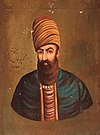 |
1705–1779 | 1773 | 1 March 1779 | Zand | |
| . | |||||||
| 21 | Abol-Fath Khan |  |
1755–1787 | 6 March 1779 | May/June 1779 | Zand | |
| He and his younger brother Mohammad Ali Khan were Co-rulers. | |||||||
| 22 | Mohammad Ali Khan |  |
1760–1779 | 6 March 1779 | 19 June 1779 | Zand | |
| He and his elder brother Abol-Fath Khan were Co-rulers until May/June 1779. | |||||||
| (21) | Abol-Fath Khan |  |
1755–1787 | 19 June 1779 | 22 August 1779 | Zand | |
| . | |||||||
| 23 | Sadeq Khan | 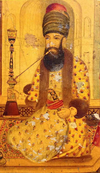 |
?–1781 | 22 August 1779 | 14 March 1781 | Zand | |
| . | |||||||
| 24 | Ali-Morad Khan | 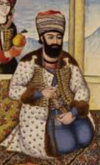 |
c. 1720–1785 | 15 March 1781 | 11 February 1785 | Zand | |
| . | |||||||
| – | Bagher Shah |  |
?–1786 | 12 February 1785 | 17 February 1785 |
— | |
| After the death of Ali-Morad Khan, Bagher Khan Khorasgani Governor of Isfahan proclaimed himself as Shah and mentioned himself in the Khutbah and on coins. He was defeated from the corps of Jafar Khan.[9] | |||||||
| 25 | Jafar Khan | 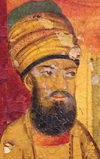 |
?–1789 | 18 February 1785 | 23 January 1789 | Zand | |
| . | |||||||
| 26 | Seyd Morad Khan | 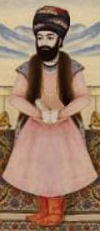 |
?–1789 | 23 January 1789 | 10 May 1789 | Zand | |
| . | |||||||
| 27 | Lotf Ali Khan | 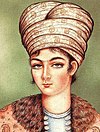 |
c. 1769–1794 | 10 May 1789 | 20 March 1794 | Zand | |
| . | |||||||
| Shah of Iran | |||||||
| (27) | Lotf Ali Shah |  |
c. 1769–1794 | 21 March 1794 | 30 October 1794 | Zand | |
| . | |||||||
Sublime State of Persia (1796–1925) | |||||||
| 28 | Agha Mohammad Shah |  |
1742–1797 | 14 May 1796 | 17 June 1797 | Qajar | |
| Agha Mohammad decided to move his capital to the small town of Tehran on 1786.[10] He was formally crowned as Shah during spring 1796 at the Mugan plain, on his return after the conquest of Tbilisi.[11][12] | |||||||
| 29 | Fath-Ali Shah | 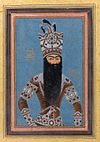 |
1772–1834 | 17 June 1797 | 23 October 1834 | Qajar | |
| . | |||||||
| 30 | Mohammad Shah | 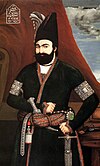 |
1808–1848 | 9 November 1834 | 5 September 1848 | Qajar | |
| . | |||||||
| 31 | Naser al-Din Shah | 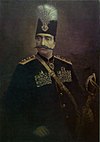 |
1831–1896 | 13 September 1848 | 1 May 1896 | Qajar | |
| Queen-mother Mahd-e Olia: 5 September 1848 – 1 October 1848. | |||||||
| 32 | Mozaffar ad-Din Shah | 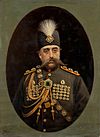 |
1853–1907 | 2 May 1896 | 8 January 1907 | Qajar | |
| . | |||||||
| 33 | Mohammad Ali Shah | 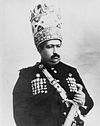 |
1872–1925 | 8 January 1907 | 16 July 1909 |
Qajar | |
| . | |||||||
| 34 | Ahmad Shah |  |
1898–1930 | 16 July 1909 | 31 October 1925 | Qajar | |
Reigned in exile: from 2 December 1923 Regency:
| |||||||
Imperial State of Iran (1925–1979) | |||||||
| No. | Name | Birth–Death | Took office | Left office | Political Affiliation | ||
| Provisional Head of State | |||||||
| 35 | Reza Khan | 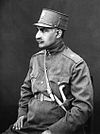 |
1878–1944 | 31 October 1925 | 15 December 1925 | Military | |
| . | |||||||
| No. | Name | Birth–Death | Took office | Left office | Dynasty | ||
| Shah of Iran | |||||||
| (35) | Reza Shah |  |
1878–1944 | 15 December 1925 | 16 September 1941 |
Pahlavi | |
| . | |||||||
| 36 | Mohammad Reza Shah | 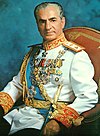 |
1919–1980 | 16 September 1941 | 11 February 1979 | Pahlavi | |
| No. | Name | Birth–Death | Took office | Left office | Political Affiliation | ||
Islamic Republic of Iran (1979–present) | |||||||
| Leader of the Revolution | |||||||
| 37 | Ruhollah Khomeini | 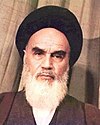 |
1900-1989 | 5 February 1979 | 3 December 1979 | Independent | |
| . | |||||||
| Supreme Leader of Iran | |||||||
| (37) | Ruhollah Khomeini | 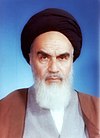 |
1900-1989 | 3 December 1979 | 3 June 1989 | Independent | |
| . | |||||||
| 38 | Ali Khamenei | 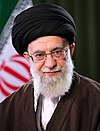 |
1939–present | 4 June 1989 | Incumbent | Independent[lower-alpha 2] | |
| . | |||||||
Close

- Is equivalent to Muharram 907 AH.
- Resigned from Combatant Clergy Association after selection as Supreme Leader.[15]
- Mikaberidze 2011, p. 432.
- Potts 2014, p. 230: "During the first nine years of his reign Shah Tahmasp was advised, in succession, by a Rumlu regent (Div Sultan Rumlu); a Triumvirate including a Takkalu (Chuha Soltan Takkalu) and an Ustajlu (Köpek Sultan Ustajlu) chief; a Takkalu (Chuha Sultan) who distributed land widely to members of his own tribe during his four years in office and was ruler of Iran in all but name; and a Shamlu (Husayn Khan Shamlu) who held his post for three years before being put to death in 1533 in alleged complicity with the Ottoman regime."
- Mitchell 2009: "Ṭahmāsp's puppet status continued with his accession to the throne on 23 May 1524, and the self-appointed status of Div Solṭān Rumlu as the Shah's Vicegerent and the Empire's De facto ruler.."
- Savory 1995: "Dīv Solṭān, by virtue of a testamentory disposition of the late Shah, retained the office of Amīr al-Omarā and was made Atābeg (Guardian) of the young prince Ṭahmāsb, who succeeded his father at the age of ten and a half. Dīv Solṭān thus became the De facto ruler of the state... After a period of negotiation, a Triumvirate was formed consisting of Dīv Solṭān Rūmlū, Čūha Solṭān Takkalū, and Kopek Ostājlū, but civil war broke out between rival Qezelbāš factions in 932 AH / 1526 AD. Kopek Solṭān was killed in 933 AH / 1526 or 1527 AD, and Čūha Solṭān succeeded in persuading Shah Ṭahmāsb that Dīv Solṭān was the cause of the discord."
- Savory 2004: "Ḥosayn Khan, however, did not draw the obvious conclusions from the fate of Čuha Sultan, but proceeded to repeat the latter's mistakes, appointing members of the Šāmlu tribe to provincial governorships and fatally underestimating the Shah's new determination to rule De facto as well as De jure."
- Savory 1982: "After the deposition of his father by Nāder Khan Afšār in Rabīʿ I 1145 AH / August 1732 AD, the eight-month-old Abbas was invested as ʿAbbās III on 7 September 1732. Nader Khan, who was the real ruler of the country, dropped his own now obviously inappropriate style of Ṭahmāsp-qolī Khan and assumed the titles of Vakīl-Al-dawla (Deputy of the state) and Nāʾeb-al-salṭana (Viceroy)."
- Perry 1991, pp. 68: "The early months of 1751 thus mark the beginning of Karim Khan's rule as Viceroy of the nominal King Ismaʿil III, a position to be hotly disputed for twelve more years but never wrested from him."
- Bamdad 2005, p. 177.
- Gharipour 2012, p. 204.
- Axworthy 2008, p. 192.
- Hambly 1963, p. 169.
- Mahbubi Ardakani 1988: "After the deposition of Mohammad Ali Shah on 16 July 1909, a regent had to be appointed because Ahmad Shah was a Minor. The choice fell on ʿAżod-al-molk. As a senior dignitary and the chief of the Qajar tribe, he enjoyed the respect of the constitutionalists and was in good relationship with the olamā. He served as regent for one year and three months until his death."
- Bakhash 2015: "Citing the disordered state of affairs in Iran, the divisions in parliament, the lack of parliamentary unanimity over his own election, he left France for Iran only in December, arriving home two months later. He did not take the Oath of office until March 1911."
- "جامعه روحانيت مبارز جوان ميشود" [Combatant Clergy Association gets younger] (in Persian). Fararu. 8 July 2012. 118101. Archived from the original on 2 September 2016. Retrieved 25 June 2016.
Bibliography
- Axworthy, Michael (2008). Iran: Empire of the Mind: A History from Zoroaster to the Present Day. Penguin Books. ISBN 978-0141903415.
- Gharipour, Mohammad (2012). The Bazaar in the Islamic City: Design, Culture, and History. Cairo: American University in Cairo Press. ISBN 978-9774165290.
- Mikaberidze, Alexander (2011). Conflict and Conquest in the Islamic World: A Historical Encyclopedia. ABC-CLIO. ISBN 978-1-59884-337-8.
- Perry, John R. [in Persian] (1991). "The Zand dynasty". In Avery, Peter; Hambly, Gavin R. G. [in Persian]; Melville, Charles P. (eds.). The Cambridge History of Iran. Vol. 7: From Nadir Shah to the Islamic Republic. Cambridge: Cambridge University Press. pp. 63–103. ISBN 978-0-52120-095-0.
- Potts, Daniel T. (2014). Nomadism in Iran: From Antiquity to the Modern Era. Oxford University Press. ISBN 978-0199330799.
- Zabir, Sepehr (2011). The Iranian Military in Revolution and War (RLE Iran D). Routledge. ISBN 978-1-136-81270-5.
- Bāmdād, Mahdī [in Persian] (2005). ʻAlīʹzādah Ishkavarī, D̲abīḥallāh (ed.). Šarḥ-i ḥāl-i riǧāl-i Īrān dar qarn-i 12 wa 13 wa 14 hiǧrī (in Persian). Tehran: Ferdows. ISBN 978-9643201395.
- Hambly, G. R. G. [in Persian] (1963). "Aqa Mohammad Khan and the establishment of the Qajar dynasty". Journal of the Royal Central Asian Society. 50 (2): 161–174. doi:10.1080/03068376308731821.
- Bakhash, Shaul (16 May 2016) [3 December 2015]. "NĀṢER-AL-MOLK, ABU'L-QĀSEM". In Yarshater, Ehsan (ed.). Encyclopædia Iranica. New York City: Bibliotheca Persica Press. Retrieved 1 January 2018.
- Mahbubi Ardakani, H. [in Persian] (18 August 2011) [15 December 1988]. "ʿAŻOD-AL-MOLK, ʿALĪ REŻĀ KHAN". In Yarshater, Ehsan (ed.). Encyclopædia Iranica. Fasc. 3. Vol. III. New York City: Bibliotheca Persica Press. pp. 271–272. Retrieved 1 January 2018.
- Mitchell, Colin P. (15 July 2009) [15 July 2009]. "ṬAHMĀSP I". In Yarshater, Ehsan (ed.). Encyclopædia Iranica. New York City: Bibliotheca Persica Press. Retrieved 1 January 2018.
- Perry, John R. [in Persian] (19 January 2012) [15 December 1998]. "ESMĀʿĪL III ṢAFAWĪ". In Yarshater, Ehsan (ed.). Encyclopædia Iranica. Fasc. 6. Vol. VIII. New York City: Bibliotheca Persica Press. p. 636. Retrieved 1 January 2018.
- Savory, Roger M. (13 July 2011) [15 December 1982]. "ʿABBĀS III". In Yarshater, Ehsan (ed.). Encyclopædia Iranica. Fasc. 1. Vol. I. New York City: Bibliotheca Persica Press. p. 76. Retrieved 1 January 2018.
- Savory, Roger M. (28 November 2011) [15 December 1995]. "DĪV SOLṬĀN". In Yarshater, Ehsan (ed.). Encyclopædia Iranica. Fasc. 4. Vol. VII. New York City: Bibliotheca Persica Press. p. 431. Retrieved 1 January 2018.
- Savory, Roger M. (23 March 2012) [15 December 2004]. "ḤOSAYN KHAN ŠĀMLU". In Yarshater, Ehsan (ed.). Encyclopædia Iranica. Fasc. 5. Vol. XII. New York City: Bibliotheca Persica Press. pp. 514–515. Retrieved 1 January 2018.